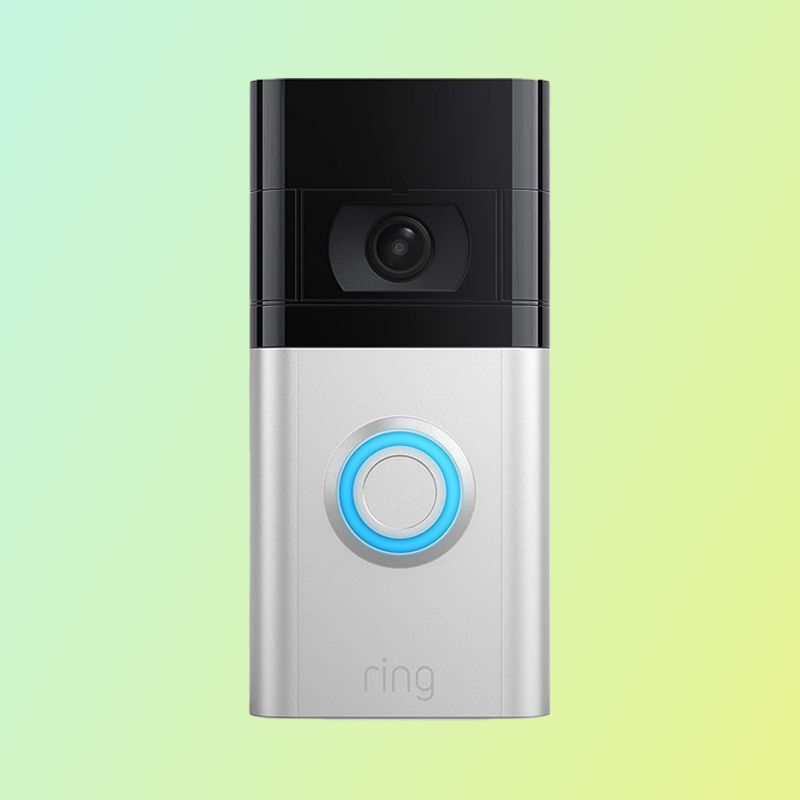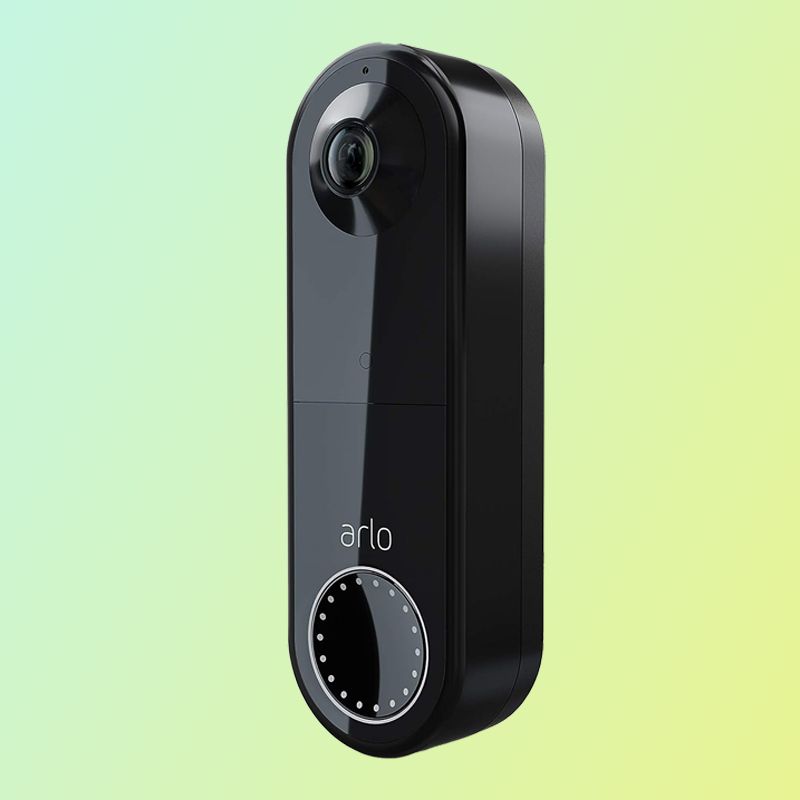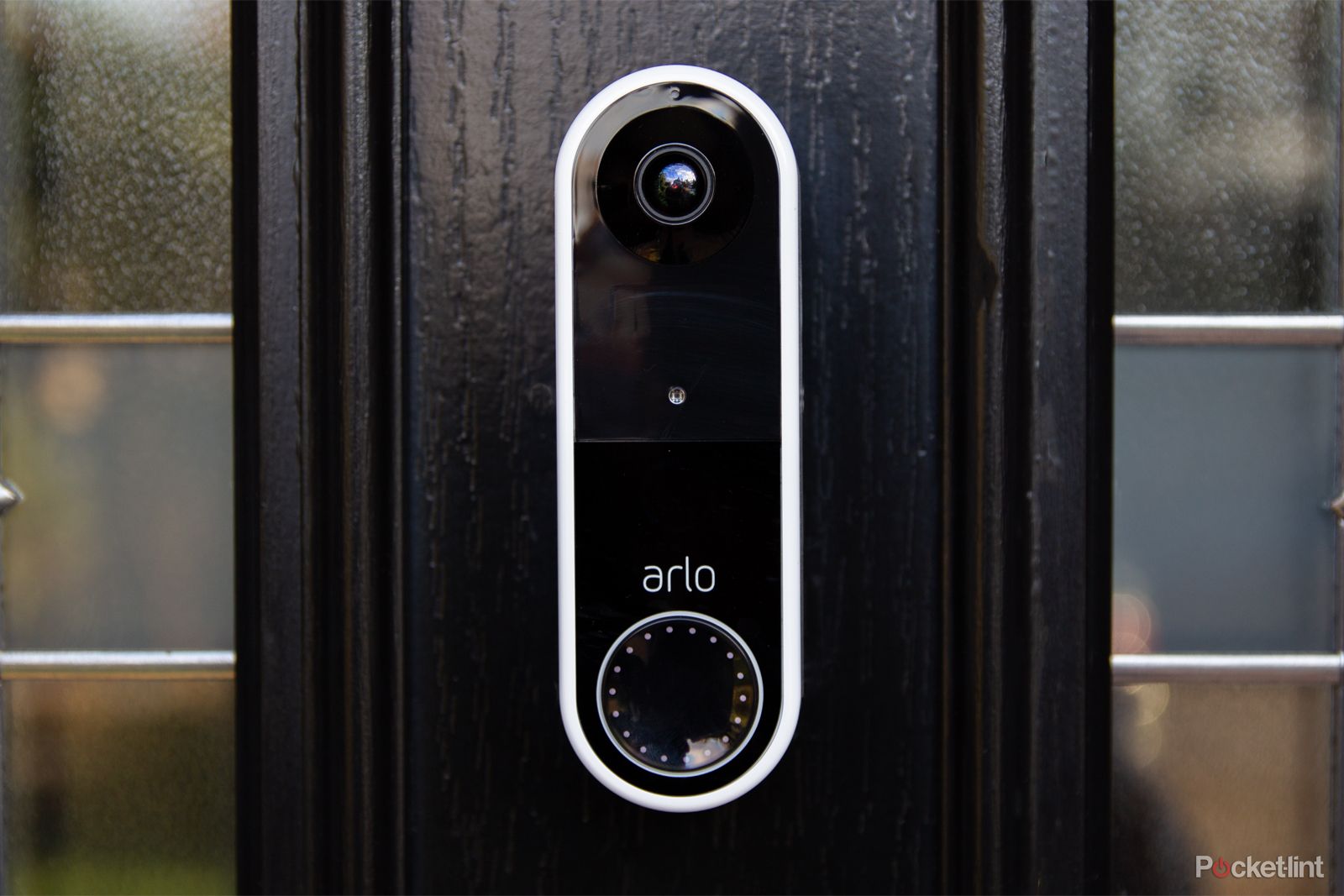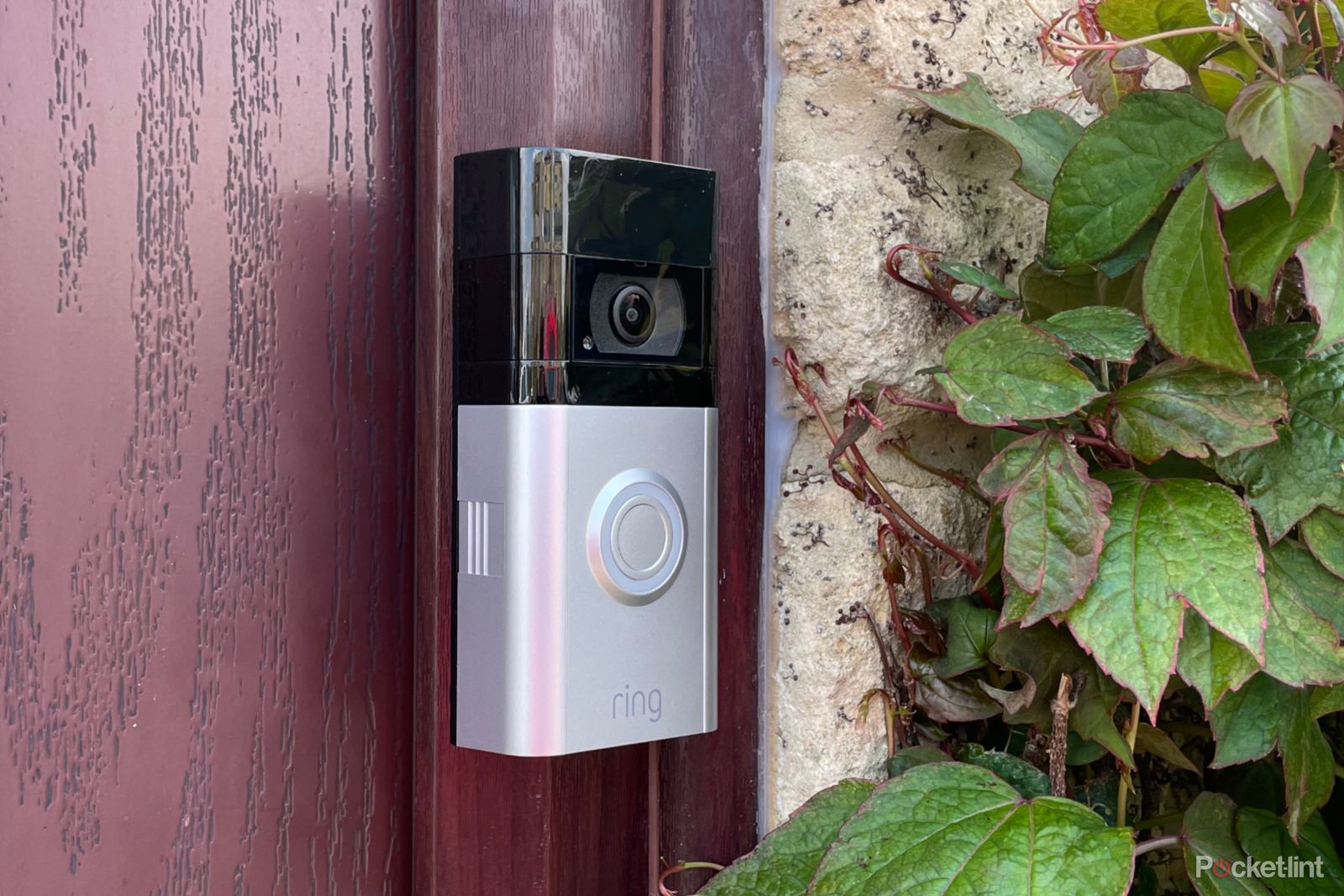-
Arlo/Pocket-lint
Arlo Essential Video Doorbell Wire-Free
Our top choice
$100 $200 Save $100
The Arlo Video Doorbell offers great video quality and a wide field of view to ensure that you can see everything that’s going on in front of your door. It’s compatible with Alexa, Google Assistant, and even HomeKit under the right circumstances.
Pros- Excellent vertical field of view
- High-quality video
- Wired version is HomeKit-compatible
Cons- Need to remove doorbell to charge battery
- No 5GHz Wi-Fi
- No HomeKit compatibility for wire-free version
-

Ring Video Doorbell 4
A great alternative
The high-quality 1080p video from your Ring Video Doorbell (4th Gen) is perfectly suited to monitoring a wide front porch. It integrates well with Echo devices to show you who is at the door, and you can access up to six months of video history with a subscription.
Pros- High-resolution video
- 2.4GHz and 5GHz compatability
- Quick-release battery
Cons- Not the best vertical field of view
- More expensive
- Only comes in one colour as standard
Key Takeaways
- A smart video doorbell offers convenience and superior experience compared to traditional doorbells, allowing you to see and communicate with visitors from anywhere.
- The Arlo Essential Video Doorbell and Ring Video Doorbell (4th Gen) are two popular models that are easy to install and have their own unique features and specifications.
- While both doorbells require subscriptions for full functionality, the Arlo Video Doorbell is significantly more affordable and offers compatibility with Apple’s HomeKit, making it a more budget-friendly option with added smart home integration.
A smart video doorbell is one of the easier ways to take your first steps into the world of smart home tech. They’re simple to install and offer a vastly superior experience to their dumb counterparts. A smart video doorbell allows you to see who is at the door from anywhere, even if you’re not at home. You can also hold a two-way conversation through the doorbell if you’re not able to come to the door. We take a look at two popular smart video doorbell models, the Arlo Essential Video Doorbell, and the Ring Video Doorbell (4th Gen) to see how they stack up.
Price, specs & availability
The Arlo Video Doorbell was launched in early 2020 and was originally priced at $149.99/£179.99. It’s now available directly from Arlo for $99.99/£90.00, and you can find the wire-free version on Amazon for $99.99 and the wired version on Amazon for as little as $60. It can be purchased in either black or white.
The Ring Video Doorbell 4 was released in 2021 and was $199/£179 when it first launched. It’s currently available from Ring for $159.99/£139.99 and can also be found for $159.99 on Amazon. The Ring Video Doorbell 4 is only sold in silver, although you can purchase additional faceplates in a range of colours including black, blue, white, and gold.
We can compare some of the key specs to see how the two video doorbells stack up.
-
Arlo Essential Video Doorbell Wire-Free Ring Video Doorbell 4 Video resolution 1536×1536 1920 x 1080 pixels Wi-Fi connectivity 2.4GHz 2.4GHz & 5GHz Battery Rechargeable Rechargeable, removable Field of view 180-degree diagonal 160-degrees horizontal, 84-degrees vertical Measurements 47 x 143 x 37mm 128 x 62 x 28mm Live View Yes Yes Two-way Talk Yes Yes Advanced Motion Detection Yes Yes Night Vision Yes Yes
Installation
The Arlo Video Doorbell comes in two models, with the wire-free version being slightly easier to install as there’s no fiddling with wires involved. It also means you have more choice over where you place your doorbell compared to the wired version. When it comes time to charge the battery, however, you’ll need to remove the entire doorbell first, which can be a little tricky.
The Ring Video Doorbell 4 is only available on one version, with a quick-release rechargeable battery that makes popping the battery out and charging it a breeze. There’s also no need to remove the entire doorbell. However, it’s possible to wire up the Ring Video Doorbell 4 to continually charge the battery, so that your doorbell never needs to be offline.
Both the Arlo Video Doorbell and the Ring Video Doorbell are simple to install and set up without too much effort. One significant difference between the two devices, however, is that the Arlo Video Doorbell can only connect to 2.4GHz Wi-Fi networks, whereas the Ring Video Doorbell works with both 2.4GHz and 5GHz networks. 2.4GHz offers better range, so if your router is a long way from your doorbell, you’re likely to get a better connection. 5GHz offers higher speeds, however, and the Arlo Video Doorbell isn’t able to take advantage.
Video quality and field of view
The Arlo Video doorbell has a maximum resolution of 1536 x 1536 which is a slightly higher vertical resolution than the standard 1080p HD. It also provides HDR video making it easier to see what’s at your door even in bright or low-light conditions. The stated 180-degree field of view is a little misleading, as this is diagonal field of view; the actual vertical and horizontal field of view is a little narrower. Despite that, it’s still more than enough to get a great vertical view of your doorway, making it easy to see any packages that have been left at the foot of your door. The horizontal field of view is also good enough for most front porches.
The Ring Video Doorbell has a resolution of 1920 x 1080, so the video quality is fairly similar to the Arlo Video Doorbell. It can also offer HDR video for better clarity in light and dark situations, although it’s possible to turn this off if you wish. The field of view is where the two video doorbells really differ; the Ring Video Doorbell 4 has a 160-degree horizontal field of view which offers a wider view than the Arlo Video Doorbell can. However, the vertical field of view is only 84 degrees, which means it’s harder to see packages left at the foot of your door, or the faces of people standing close to the doorbell. If you have a wide front porch however, the Ring Video Doorbell can offer much better coverage than the Arlo Video Doorbell can.
Pocket-lint
Features
While both video doorbells offer limited functions for free, to take full advantage of all that they have to offer, you’re going to need a subscription. This can feel a little frustrating after you’ve forked out for the video doorbell in the first place, but it seems to be the case that the majority of major video doorbell brands are set in their ways with subscription models.
The Arlo Secure subscription costs from $3.99 per month for a single device, and offers cloud video up to 4K quality, 30 days of cloud video history, interactive notifications, person, vehicle, and animal detection, and package detection. From $14.99 per month, you get the Secure Plus subscription, which gives you all of the Secure features across unlimited devices and adds 24/7 emergency response and critical alerts.
Ring Protect Basic costs $3.99 per month for a single device, and includes video history for up to 180 days, video saving and sharing, person alerts, snapshot notifications, and home and away modes. Ring Protect Plus is $10 per month and provides the same features as Ring Basic for unlimited devices, as well as the addition of extended warranties. There’s also a Ring Pro subscription for $20 per month, but all of the additional benefits apply to Ring alarm systems rather than the Ring video doorbells.
There’s little difference between the two options in terms of cost and both services offer some similar features, such as package detection that alerts you when a parcel has been delivered to your door. Both subscriptions have the positives and negatives, however. Ring offers much longer video history, so you can see video from as far back as 6 months ago, compared to just 30 days with the Arlo Secure subscription. However, Arlo offers more specific motion detection, detecting people, vehicles, and animals, so you don’t get alerted unnecessarily.
Smart home compatibility
Being able to interact with your doorbell using your phone is great, but what happens when the doorbell rings and your phone is upstairs? It’s almost easier to just go and answer the door the old-fashioned way. Thankfully, both video doorbells integrate nicely with Alexa and Google Assistant, allowing you to talk to people at the front door through your smart speaker. If you have an Alexa smart speaker with a screen, such as an Echo Show you can see the live feed from both the Ring Video Doorbell and the Arlo Video Doorbell directly on the screen. With the Arlo Video Doorbell, you can also stream the live video feed to a Google Nest Hub or Nest Hub Max, but this isn’t possible with the Ring Video Doorbell.
One major difference between the two devices is that the wired version of the Arlo Video Doorbell is HomeKit-compatible, meaning that you can integrate into your Apple smart home ecosystem, and add it to the Home app. Not many of the major smart doorbells work with HomeKit, so this is a big plus-point if your home is focused on Apple gear. However, if you want to connect your Arlo Video Doorbell to HomeKit, you’ll need an additional Arlo hub.
Despite stating that the wire-free Arlo Video Doorbell would eventually support HomeKit, unfortunately, this still isn’t the case. The none of the video doorbells offered by Ring are compatible with HomeKit, including the Ring Video Doorbell 4.
Arlo Video Doorbell vs Ring Video Doorbell: Which should you choose?
There’s not a huge amount to choose between the Arlo Video Doorbell and the Ring Video Doorbell 4. Both doorbells have a lot of great features, and one or two niggling faults. They both also have subscriptions at a similar price point that offer a lot of the same features.

Arlo/Pocket-lint
Arlo Essential Video Doorbell Wire-Free
Our top choice
$100 $200 Save $100
Excellent vertical field of view and high-quality video at an excellent price.
At the end of the day, there’s one significant factor that gives the Arlo Video Doorbell the edge, and that’s the price. It’s possible to purchase an Arlo Video Doorbell at little over a third of the price of a Ring Video Doorbell 4. With high-quality audio, a great vertical field of view that lets you spot packages left right outside your door, and compatibility with HomeKit under the right circumstances, at current prices you really can’t go wrong.

Ring Video Doorbell 4
A great alternative
An ideal choice for wide front porches thanks to the 1920×1080 resolution and wide horizontal field of view.
If you’re willing to spend a little more, however, then the Ring Video Doorbell 4 is still a great choice, especially if you want to take advantage of the speed of your 5GHz Wi-Fi network. It’s also particularly well suited to wider porches, with a wide horizontal field of view that will let you see more of your porch than the Arlo Video Doorbell can. If you’ve got Alexa devices at home, the Ring Video Doorbell also integrates very nicely.
Trending Products

Cooler Master MasterBox Q300L Micro-ATX Tower with Magnetic Design Dust Filter, Transparent Acrylic Side Panel, Adjustable I/O & Fully Ventilated Airflow, Black (MCB-Q300L-KANN-S00)

ASUS TUF Gaming GT301 ZAKU II Edition ATX mid-Tower Compact case with Tempered Glass Side Panel, Honeycomb Front Panel, 120mm Aura Addressable RGB Fan, Headphone Hanger,360mm Radiator, Gundam Edition

ASUS TUF Gaming GT501 Mid-Tower Computer Case for up to EATX Motherboards with USB 3.0 Front Panel Cases GT501/GRY/WITH Handle

be quiet! Pure Base 500DX ATX Mid Tower PC case | ARGB | 3 Pre-Installed Pure Wings 2 Fans | Tempered Glass Window | Black | BGW37

ASUS ROG Strix Helios GX601 White Edition RGB Mid-Tower Computer Case for ATX/EATX Motherboards with tempered glass, aluminum frame, GPU braces, 420mm radiator support and Aura Sync












